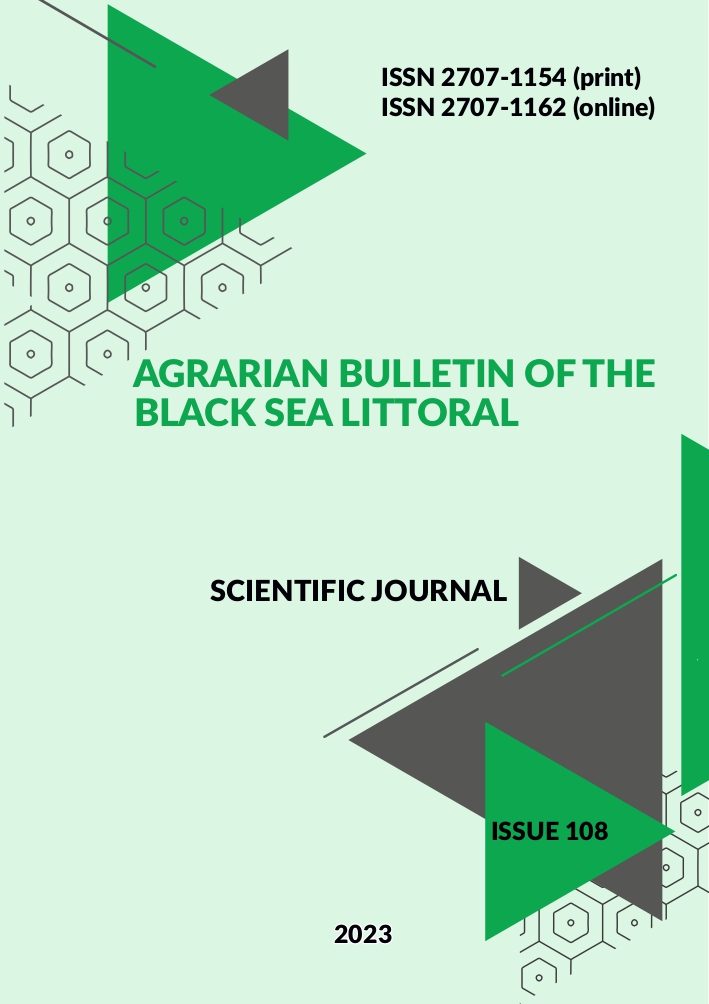CONTENT OF BIOLOGICALLY ACTIVE COMPOUNDS IN FRUITS OF CAPSICUM ANNUUM L
DOI:
https://doi.org/10.37000/abbsl.2023.108.09Keywords:
capsaicinoids, carotenoids, Capsicum annuum L., anti-inflammatoryAbstract
The study of the chemical composition of natural raw materials allows not only to obtain data on the peculiarities of its structure and organization, but also to find new chemical compounds with useful qualities. The search for new biologically active compounds that can be used in pharmacology and pharmacy, food chemistry, and experimental research in various areas is particularly effective.
The aim of the work was to determine the quantitative content of capsaicinoids and carotenoids in the fruits of Capsicum annuum L.
Ripe fruits of Capsicum annuum L. varieties Ukrainian bitter, Kharkiv bitter, Astrakhansky, Kharuz were selected for the study. The fruits were dried to a constant weight. The study of the content of capsaicinoids was carried out with their preliminary separation using thin-layer chromatography, after which the optical density was measured by the photocalorimetric method. To study the content of carotenoids, they were pre-cleaned from other extractive substances, after which the optical density was measured by the photocalorimetric method.
It was established that the fruits of all studied varieties meet the state standard for the content of capsaicinoids. The predominant capsaicinoid was capsaicin (60-80%). The content of dihydrocapsaicin ranged from 15 to 30%. The total content of carotenoids for most varieties exceeded 2 mg / 1 g of fruit pulp. The predominant fraction was red (60-70%).
The fruits of all studied varieties of Capsicum annuum L. can be used as plant raw materials for the further production of pharmaceutical preparations.
References
Jain P. Inflammation: Natural resources and its applications / P. Jain, R. Pandey, S.S. Shukla // Springer; 2015. – 175 p.
Mueller M. (2010). Anti-inflammatory activity of extracts from fruits, herbs and spices / M. Mueller, S. Hobiger, A. Jungbauer // Food Chemistry. – 2010. – Vol. 122, N 4. – P. 987-996.
Anti‐inflammatory effects of red pepper (Capsicum baccatum) on carrageenan‐and antigen‐induced inflammation / F. Spiller, M.K. Alves, S.M. Vieira [et al.] // Journal of Pharmacy and Pharmacology. – 2008. – Vol. 60, N 4. – P. 473-478
Topuz A, Ozdemir F. Assessment of carotenoids, capsaicinoids and ascorbic acid composition of some selected pepper cultivars (Capsicum annuum L.) grown in Turkey / A. Topuz, F. Ozdemir // J. Food Composit. Anal. – 2007. – Vol. 20, N 7. – P.596-602
Antioxidant, Antinociceptive, and Anti-Inflammatory Effects of Carotenoids Extracted from Dried Pepper (Capsicum annuum L.) / M. Hern´andez-Ortega, A. Ortiz-Moreno, M.D. Hern´andez-Navarro, [et al.] // J. Biomed. Biotech. – 2012. – Vol. 2012. – P. 1-10
Systematic review of topical capsaicin for the treatment of chronic pain / L. Mason, R.A. Moore, S. Derry [et al.] // BMJ. – 2004. – Vol. 328, N 7446. - P.991
Capsaicin causes cell-cycle arrest and apoptosis in ER-positive and-negative breast cancer cells by modulating the EGFR/HER-2 pathway / N.H. Thoennissen, J. O'kelly, D. Lu [et al.] // Oncogene. – 2010. – Vol. 29, N 2. – P. 285-296
Proteomic analysis for antiobesity potential of capsaicin on white adipose tissue in rats fed with a high fat diet / J.I. Joo, D.H. Kim, J.W. Choi [et al.] // J. Proteome Res. – 2010. - Vol. 9. – P. 2977–2987
Peng J. The vanilloid receptor TRPV1: role in cardiovascular and gastrointestinal protection. / J. Peng, Y.J. Li // Europ. J. Pharmacol. – 2010. – Vol. 627, N 1. – P. 1-7
Pankar D.S. New method for the determination of the capsaicin by using multi-band thin-layer chromotography/ D.S. Pankar, N.G. Magar // J. Chromatogr. - 1977. - Vol. 144. – P. 149-152
Stefanov O.V. Preclinical studies of drugs / О.V. Stefanov // K.: «Avicena», 2001, p. 528
Variation of antioxidant activity and the levels of bioactive compounds in lipophilic and hydrophilic extracts from hot pepper (Capsicum spp.) cultivars / H. Bae, G.K. Jayaprakasha, J. Jifon, [et al.] // Food Chem. – 2012. – Vol. 134, N 4. – P. 1912-1918
Reyes-Escogido M.D. Chemical and pharmacological aspects of capsaicin / M.D. Reyes-Escogido, E.G. Gonzalez-Mondragon, E. Vazquez-Tzompantzi // Molecules. – 2011. – Vol. 16, N 2. – P. 1253-1270.
Kaulmann A. Carotenoids, inflammation, and oxidative stress—implications of cellular signaling pathways and relation to chronic disease prevention / A. Kaulmann, T. Bohn // Nutrition Res. – 2014. – Vol. 34, N 11. – P. 907-929.


